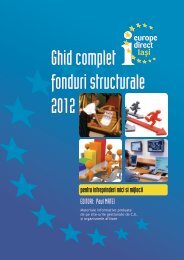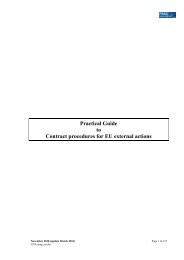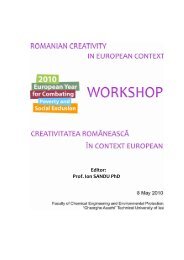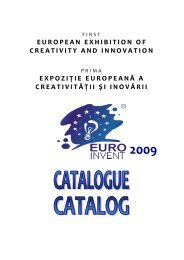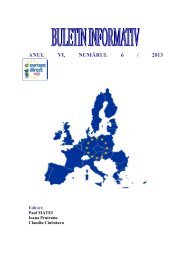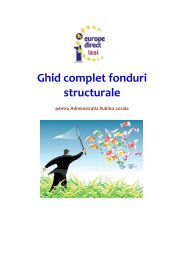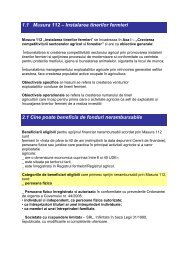eur op eanexhibitionofcreati vityandinnovation - Europe Direct Iasi
eur op eanexhibitionofcreati vityandinnovation - Europe Direct Iasi
eur op eanexhibitionofcreati vityandinnovation - Europe Direct Iasi
You also want an ePaper? Increase the reach of your titles
YUMPU automatically turns print PDFs into web optimized ePapers that Google loves.
EUROINVENT 2013<br />
“Petru Poni” Institute of Macromolecular Chemistry, <strong>Iasi</strong><br />
37.1.<br />
Title EN<br />
Authors<br />
Institution<br />
Description<br />
EN<br />
Class no.<br />
New Partially Aliphatic C<strong>op</strong>olyimides Films Modified by<br />
Plasma Treatment for High Performance Applications<br />
Dumitru P<strong>op</strong>ovici (1) , Irina Andreea Barzic (1) , Maria<br />
Butnaru (2) , Iuliana Stoica (1) , Camelia Hulubei (1) , Ghiocel<br />
Emil Ioanid (1) , Stelian Vlad (1)<br />
(1)<br />
“Petru Poni” Institute of Macromolecular Chemistry,<br />
<strong>Iasi</strong><br />
(2)<br />
“Gr. T. P<strong>op</strong>a” University of Medicine and Pharmacy,<br />
<strong>Iasi</strong><br />
Polyimides are characterized by some outstanding pr<strong>op</strong>erties, such<br />
as superior thermal and chemical resistant, excellent mechanical<br />
strength and good adhesion to surfaces. As a result, they have been<br />
extensively used in aerospace, microelectronics, <strong>op</strong>toelectronics,<br />
composites and membranes. Also, polyimides have been proved to be<br />
biocompatible, with applications in biomedical fields as substrate/<br />
encapsulation materials in bio-micro-electromechanical-systems<br />
(Bio-MEMS) or as micro-structured substrates for contact guidance<br />
of osteoblast cell growth.<br />
Novel c<strong>op</strong>olyimides based on 3,3’,4,4’-benz<strong>op</strong>henontetracarboxylic<br />
dianhydrides, 4,4’-diaminodiphenylmetane and 1,6-diaminohexane<br />
were synthesized and their corresponding films were obtained. By<br />
cold plasma treatment the films surfaces wettability has been<br />
improved. Polar component contribution to surface tension have been<br />
enhanced from 10 to 50%, increasing the surface hydr<strong>op</strong>ho-bicity<br />
characteristics and decreasing interfacial tension with blood in the<br />
range of 2.07–2.95 mN/m, in accord with the biocompatibi-lity<br />
criteria. The results have reflected the capacity of aliphatic moieties<br />
to lower the electron-donor character of polar contribution to surface<br />
tension, while maintaining a small adhesion of polymer films to red<br />
blood cells and a pr<strong>op</strong>er cohesion to platelets, albumin, fibrinogen<br />
and immunoglobulin. By increasing aliphatic content in polyimides<br />
chains, the rejection of platelets has been increased, prohibiting<br />
thrombosis and favoring cohesion with plasma proteins.<br />
Atomic force microsc<strong>op</strong>y data have revealed a uniform and flat<br />
surface morphology for untreated samples (Sq = 0.31–0.48 nm),<br />
changing into a granular structure after plasma treatment with<br />
surfaces roughness Sq < 8 nm for all polyimides films, being<br />
favorable for laminar blood flow, preventing poststenotic turbu-lence<br />
and clot formation.<br />
Acknowledgements. This work is financially supported from PN-II-<br />
ID-PCE-2011-3-0937, Project No. 302 / 5.10.2011, Stage 2013<br />
Innovative Researches<br />
NATIONAL<br />
209



